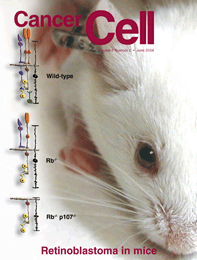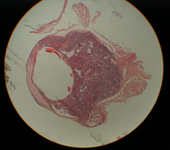| |
Animal Model for the Childhood Eye Cancer Retinoblastoma
 Retinoblastoma is a childhood cancer caused by inactivation of the Rb tumour suppressor gene. The Rb gene is part of a pathway that is defective in ~90% of human tumors. The retina is exquisitely sensitive to Rb loss. Patients who inherit one defective allele have a 90% chance of developing retinoblastoma. They also have an increased chance of developing osteosarcoma, but only ~2-3% will develop this condition. Other cancers are much rarer in these patients. Retinoblastoma is a childhood cancer caused by inactivation of the Rb tumour suppressor gene. The Rb gene is part of a pathway that is defective in ~90% of human tumors. The retina is exquisitely sensitive to Rb loss. Patients who inherit one defective allele have a 90% chance of developing retinoblastoma. They also have an increased chance of developing osteosarcoma, but only ~2-3% will develop this condition. Other cancers are much rarer in these patients.
Why is the retina so sensitive to Rb loss?
Why are the other tissues so much more resistant?
Understanding the wiring in resistant or sensitive cells will enhance the design of drugs that boost protective mechanisms in tumor prone cells. Because Rb is involved in many human tumors (breast, bladder, lung, bone, etc), the insights we gain from studying the retina will likely have broad utility for treatment of cancer in other tissues.
Our strategy for probing this fundamental issue has been to develop the first inheritable mouse model of retinoblastoma induced by Rb loss. Details of this work are described in the paper outlined in News.
Other major questions that our new model allow us to tackle include:
Why do some cancers (like retinoblastoma) arise in fewer genetic steps than others?
What are the unique properties of the cell of origin of retinoblastoma that make it tumor prone in the absence of Rb?
What are the genetic steps, beyond Rb loss, that drive tumor growth?
What downstream effectors that mediate the effects of Rb loss in different cell types?

|
|







